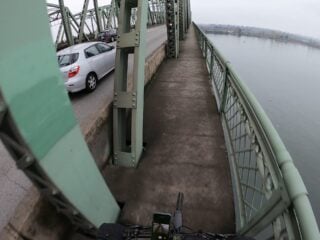
(Photo: Jonathan Maus/BikePortland)
Wednesday evening is the first meeting of the community advisory group (CAG) for the I-5 Bridge Replacement program — the new effort from Washington and Oregon departments of transportation to improve the crossing of the Columbia River between Portland and Vancouver. It’s one of three advisory groups that will help the DOTs avoid the fate of the failed Columbia River Crossing project.
Getting to the bridge and crossing the river is currently terrible for bicycle users and this project could attract billions of federal dollars to make it better. It’s a once-in-a-lifetime opportunity to make it easy to bike between these two growing cities — both on the bridge itself and on street connections on both ends.
However, despite the importance of bicycling in this project and the project’s own contention that the CAG will, “develop recommendations to help ensure the program outcomes reflect community needs, issues and concerns,” the 32-member body does not include anyone who represents a cycling advocacy group.
Advertisement
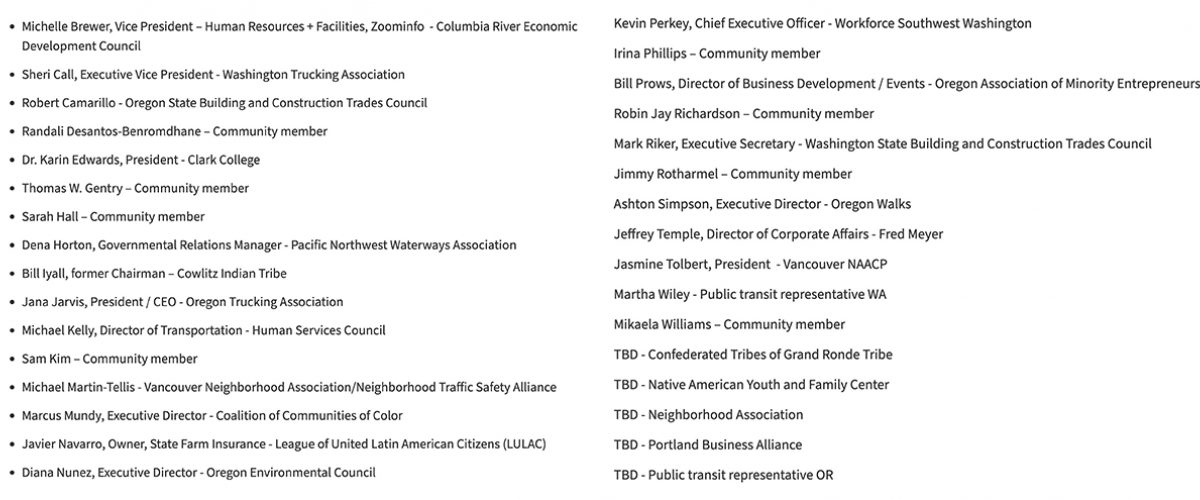
The CAG includes members who represent a myriad of interests including: Washington Trucking Association, Clark College, Oregon Walks, Portland Business Alliance, Cowlitz Indian Tribe, Oregon Trucking Association, Oregon Environmental Council, Fred Meyer, Columbia River Economic Development Council, Pacific Northwest Waterways Association, Oregon State Building and Construction Trades Council, two public transit representatives that are yet to be named, and several others.
Not one name on the list is from a bicycling organization from either side of the river.
Asked about this oversight, IBR Program Administrator Greg Johnson told BikePortland via email:
“As part of the process to identify members, the selection committee carefully considered the overall makeup of the group to ensure a diverse range of stakeholder interests and backgrounds are represented on the group. Active transportation interests were certainly part of this consideration and several of the at-large members of the Community Advisory Group identified themselves as avid cyclists. In particular, one of those members indicated that they commute across the bridge by bike each weekday for work.
In addition to making sure that the cyclist perspective is represented on the Community Advisory Group, we are planning many different ways for community members to provide input on the program. We anticipate specific opportunities to ensure the cyclist and pedestrian perspectives are engaged in a meaningful way, such as a potential working group to inform specific conversations around bike and pedestrian facilities when we begin to discuss the potential design details of possible alternatives.”
Advertisement
This is very unfortunate (yet part of a familiar pattern at ODOT).
There’s a vast difference between self-described “avid cyclists” on a committee representing themselves, versus a professional advocate who’s there to speak up for bicycling in general (and who carries the weight of an organization behind them). And having “bike and pedestrian facilities” discussed as a “potential design” and “possible alternatives” comes nowhere close to cutting it.
There are several nonprofits in the Portland and Vancouver areas who would have been important additions to this process: WashCo Bikes, The Street Trust, Bike Loud PDX, Bike Clark County, Cascade Bicycle Club, Washington Bikes, and Vancouver Bicycle Club just to name a few. And this list doesn’t include micro-mobility companies like Lyft and Spin whose customers are likely to be major users of a new bridge and other infrastructure.
It’s almost as if the DOTs don’t think bicycling and micromobility use are important enough to merit representation.
Keep in mind, ODOT is already in the hot seat for doing a bad job getting feedback from bicycle users. Back in September, The Oregonian reported on a state audit that pointed out how ODOT, “doesn’t do enough to reach out to bike and pedestrian advocacy groups about how they are affected by massive state transportation projects and those constituent groups are omitted from a powerful state committee that is dominated by freight interests.”
This is not a good start to a process that already faces deep skepticism from many corners. If the DOTs want this project to succeed, the process needs to be fair and accessible to everyone who will use the bridge.
Learn more about this project and get CAG meeting details here.
— Jonathan Maus: (503) 706-8804, @jonathan_maus on Twitter and jonathan@bikeportland.org
— Get our headlines delivered to your inbox.
— Support this independent community media outlet with a one-time contribution or monthly subscription.



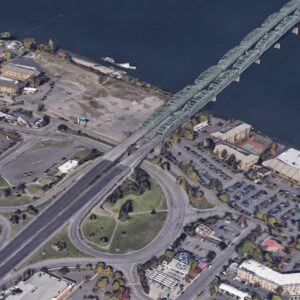
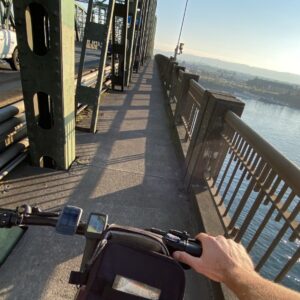

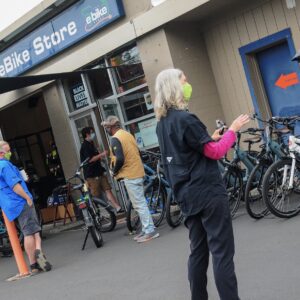
Thanks for reading.
BikePortland has served this community with independent community journalism since 2005. We rely on subscriptions from readers like you to survive. Your financial support is vital in keeping this valuable resource alive and well.
Please subscribe today to strengthen and expand our work.
This only speaks to the lack of leadership at the Street Trust. They are supposed to be the statewide advocacy group but they have been MIA for the last 3 sessions and never return my emails. So I’m not surprised they aren’t on this committee. Gerik had to resign in disgust the first time around because ODOT won’t listen to biker’s anyway.
I don’t want to be a complete downer here, but who is ODOT supposed to put on that committee to represent bikes? Parametrix is leading the public consultation for the I-5 Bridge. PMX already sponsored the Street Trust annual gala back in October, so I guess that’s our representation.
No, Jamie. That’s not it.
There was a really good plan to accommodate bicyclists and pedestrians in the previous CRC plan, including on the bridge (a separated facility on a lower level beneath the cars and trucks – the Max trains were also on a lower level, in the other bridge span) and a comprehensive set of connections to the lanes, trails, and paths on both sides of the river and on Hayden Island itself. All of the freeway ramps featured grade separations.
With a general desire to make it cheaper, the great bicycle/pedestrian and transit facilities are likely to be eliminated or reduced in scope.
What happened to that plan?
Shoes and pedals were well represented in both Common Sense Alternatives, too.
“I’ve seen more auspicious starts.”
If the body has no real power, and most CAGs don’t, then it should be an honor not to have any bike groups on it.
The group you really want your bike advocates on is the technical advisory committee or its equivalent – people with real power, like engineers.
Exactly. A 32 member committee where everyone is looking out only for their own narrow interest is guaranteed to be an unproductive yak fest.
There’s a legitimate question of how to represent cycling, and given what is represented, it’s a glaring omission. Having said that, I don’t believe members of cycling advocacy groups represent the larger cycling community better than those who aren’t even if I also think it’s important to have the perspectives of people who actually use walking, cycling, etc. to get around.
I’m not worried about this project. The current arrangement is pretty bad unless you have the bridge to yourself, but you know at a minimum they’ll have wider paths that people will be able to get by each other on. Realistically, this will never have that many people on it at the same time so it won’t be that bad no matter what they do.
I’m also dismayed that we don’t have a bike advocacy group represented on the I5 CAG. I have lived in both Portland and Vancouver and have two kids 6 and 10 that both love to ride with me. I live in Vancouver now, and while we have relatively good facilities and development of bikeways here I would love to be able to take advantage of the great trail system in North Portland along the Slough and out to Kelly Point park if only the I-5 Bridge weren’t so terrifying to cross. I do it regularly for commuting to my job in St Johns but I took my son who was 9 at the time across it once to ride the Slough trail and he told me that he didn’t ever want to ride it again.
I applied as a citizen to be on the CAG but it’s pretty clear they were only selecting people who represented larger organizations and whose voice would represent a larger community. Do you know if any of the organizations you listed in the article applied to be represented on the committee? If so, I would be even more incredulous that they didn’t get a seat at the table.
The reality is there are not many people who are like you and money is much better spent on making things better for the vast majority of this state, not just priviliged able bodied small minority. What you want is basically a private road for yourself at the expense of those who you detest.
5.3% of Portland useds bikes. Yet the loudest voices are from bicylists. The city built a bidge for bicyclists, keep taking lanes from motorists, for bike lanes never used. How is that fair?
Ah. This is beginning to sound like just sour grapes. I get it, you think cyclists are only privileged, able bodied white men, all kitted out in spandex, on bikes that cost nearly as much as your car? Because I can assure you that’s not the case. You know there are disabled cyclists, right?
“As an avid cyclist, I wouldn’t mind getting rid of bike lanes and just riding on the shoulder of the interstate on this new I-5 bridge. Hey, it’s worked on I-84 for decades. Sounds like a great plan, let’s build it.”
Riding on the shoulder of freeways works, except where there are ramps. Many ramps on I-5 in the Portland metro area carry 1500 to 1800 vehicles per hour. Do you really want to try to cross a ramp on your bike when there’s a car every 3 seconds going 50+ mph?
I think that’s called “sarcasm,” J_R.
Fred, that’s what I was hoping it was.
I think Eudaly’s brilliant idea of putting bicycle lanes at places they were not used really at all while taking lanes away from very busy routes really soured people’s intrest in bicycle lanes. With that much traffic like 1500-1800/hr, why do we build bicycle lanes that serve 3-4 people per hour? Bicycle lanes are great for some areas, but Eudaly in her hate against vehicles actually did more damage to bicycle ridership by deliberately screwing over them and making bicyclists look like the bad people.
Even if there was a bike advocate on the advisory group, it would just be a token one. Advisory groups have two types of people.You have your monied policy makers like Jana Jarvis who is there with enough political bribes…er donations and influence to effectively dictate policy and design and then you’ve got the token pieces like Ashton Simpson who is member for the sole purpose of allowing ODOT to pretend it cares what non-heavy freight thinks about the project design.
Rose quarter AC part two.
Power comes through action, not advisory committees
Give me a break – bicycle lobby has a very outsized voice in every situation compared to actual ridership numbers. There is only 5% or so bicyclists yet so many decisions are pro bicycle. Please at least be realistic instead of posting conspiracy theories.
1. Very few decisions are actually pro bicycle.
2. The primary purpose of pro bicycle decisions is not to help current bicyclists, but to help everyone by increasing the number of bicyclists.
Very few decisions? There are tens of miles of bicycle lanes that are almost never used. Many city hall meeting the bicyclists invade and don’t let others go in, not to mention bicycle ridership keeps declining but we built a bridge for bicycles and max. Portland give bicyclists an oversized vote even though they do not pay taxes for the roads with gas tax, and there are fewer and fewer of them. Bicycles are not a solution to Portland. They are great, but the whining that it is a token one etc is pretty insane considering how many pro-bicycle decisions keep coming out of Portland despite how fewer people are riding.
If this was actually a fair representation, we would not be taking lanes from insanely congested places and make them more congested so we can put more bicycle lanes that are never used.
The hypocrisy is insane. And also on one hand you say there are not many, on the other hand you say they help new people to get in to bicycling. Which is it? And it is clearly not a good system. If anything, the unused bicycle lanes while people are stuck in traffic just makes people vote against any such future improvements.
Jamie, it sounds to me like you don’t actually know what *pro bicycle* even means. There should be a downvote button here.
I have been a cyclist in the area for years and applied to be on the committee. I was told there were 500 applicants – I’m sure I wasn’t the only cyclist who applied. Seems like with a pool of 500 there were lots of opportunities to get representation from cyclists. I agree with the reader below who mentioned that CAG groups have little power, but have also seen how skewed they can be toward car owners and people who love to complain about parking. They can be a veritable echo chamber.
Thanks for this excellent coverage of an important issue. As I was reading the article, I was laughing as I thought of a sarcastic reply I would write – something along the lines of “C’mon, Jonathan! A person on the committee probably rides a bike!”
Imagine my surprise when someone from ODOT actually *went there*! They are obviously so out of touch. I won’t be at all surprised when they come up with a design that shunts bicycles to some far-off catwalk with 90-degree turns and stairs you have to carry your bike up and down.
Probably because less and less people drive bicycles nowadays? Bicycle rights are over represented as it is.
If “less and less people drive bicycles nowadays”, but bike sales are way up in the past year, what do you suppose people are doing with all those bikes?
Why, they put them in the garage next to the freezer (to pre-age the tires) and take them out twice per year, by car, to the nearest state park to bicycle with relatives and friends, of course, like most wholesome Americans, or at least the 26% who own bicycles. They might even pump up the tires beforehand.
Nice deflection lol. Who cares what they do with it – there are just simply not that many bicyclists and it keeps declining. This is from this site.
“The latest numbers from the U.S. Census bureau estimate that the number of people who bike to work in Portland is down to 5.3%. That number is down from 6.3% in 2017 and it’s the lowest we’ve seen since 2007. Portland’s bike to work number peaked at 7.2% in 2014.”
https://bikeportland.org/2019/09/26/us-census-portland-bike-commuting-hits-lowest-rate-in-12-years-305326
Cycling deaths are also way up, Jamie. You think that might be related?
Since I don’t see the link I posted in the above comment, I will put it here.
https://www.outsideonline.com/2420196/what-we-learned-tracking-cycling-deaths-year